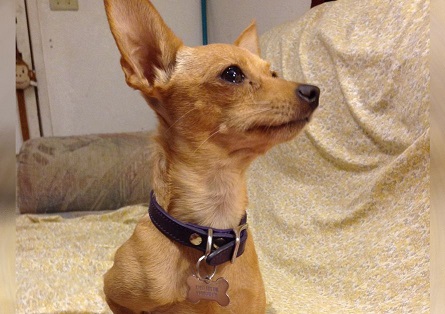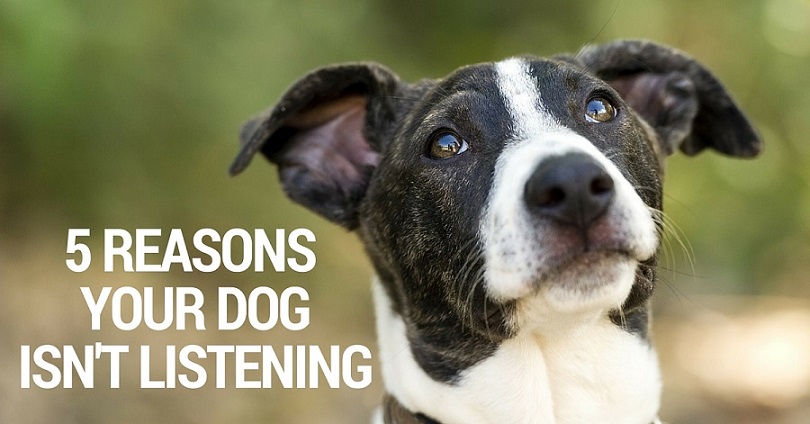Does your dog ever ignore you?
Does it ever feel as though she’s testing you, like a cheeky toddler? Or as though she might be spiting you for abandoning her when you go to work each day?
Fortunately, she isn’t. Dogs are better than that.
There’s five common reasons why your dog isn’t listening to your commands, even if she seems to already know better. I promise, none of these reasons are ever going to be spite or malice.
Note: I’m Lindsay Pevny (the “other” Lindsay!) and I am the founder of the blog Little Dog Tips.
5 reasons your dog isn’t listening to you
1. Your dog is distracted.
Dogs have a sense of smell that’s 10,000 to 100,000 times more powerful than ours, and a sense of hearing more than 4 times more acute.
I imagine being outside to dogs is what being online is to us. You might hop on the computer to find a recipe, only to get lost for hours in a sea of status updates, catchy headlines and cute videos. Dogs must feel the same way when they’re in an unfamiliar location.
With so many interesting sounds and smells competing for your dog’s attention, it’s not surprising that she’d find it difficult to listen to your commands.
If you need your dog to always listen, even if she’s distracted, you’ll need to work on proofing – training your dog in a variety of settings and distractions so she is trained everywhere.
Keep your expectations reasonable; for example, don’t let your dog off-leash at the park until she is trained to reliably come when called in different settings.
Be sure to use high-quality rewards when training your dog in distracting areas – the smellier, the better.
2. Your dog is rusty.
Remember when you learned advanced calculus all year in high school, but after a summer of no homework, you could barely do basic multiplication?
Without practice, a dog’s skills can fade away, too. If it has been a while since you last worked on a particular behavior, act as though you are teaching it for the first time. Praise her for close attempts, and work your way back up to her previous skill level.
When you teach a new trick, it’s better to spend 10 minutes on it daily, than to teach it for an hour and forget about it for the rest of the month. To get the more practice in without over-treating your dog, you can use part of your dog’s meals as rewards and practice commands with her throughout the day.
3. Your dog is frustrated.
After failing to please you, your dog might show signs of shutting down. She may look away, lick her lips, yawn, or start to scratch – all subtle stress signals that exclaim, “Cool it! I don’t know what to do!”
When your dog shows signs of frustration, lighten the mood by playing with a toy, or lying down for a snuggle. You might not realize that you’re getting frustrated, too, and your dog can hear it in your voice.
To prevent frustration, keep your expectations reasonable. If your dog gets a command wrong three times in a row, make it easier. When you’re first teaching a new behavior, reward your dog for her attempts. Keep your training sessions short and spread out, and always end on a good note.
4. Your dog doesn’t understand English.
When you teach your dog a new command, you need to first get her to understand the meaning of the word. It doesn’t make sense to repeat the word over and over before she knows what it means. At that point, it’s just a meaningless noise.
The more you repeat a command, the more meaningless it becomes – kind of like when you say any word 100 times, and it begins to sound foreign.
Here’s the right way to train the one command every dog should know – sit. First, hold the treat near the dog’s nose and wait for her to sit. The moment that booty goes down, reward her, and say “yes!” or click your clicker. After a few times, she’ll begin to sit for the treat, and only then can you introduce the command.
Say, “sit!” while your dog is planting herself into a sit. It’s much easier for your dog to understand a command that’s said once, the moment she does it.

5. You talk too much.
We humans are very verbal creatures, while dogs mainly communicate with their body language. We can miss out on many of their nonverbal cues when we’re too busy listening to ourselves talk away.
This is especially true when our dogs do not respond the way we’d like on the first try. Many dog owners repeat commands, getting louder and louder with each repetition until the dog coincidentally does the right thing.
Talking to your dog too much can annoy her, and even cause to tune you out. Resist the urge to repeat a command when your dog does not respond the first time.
Instead, look at your dog’s body language. Is she distracted? Stressed? Frustrated? Or does she not understand the command? Before you repeat yourself, consider what you can do to make it easy for her to listen better, whether it’s more practice, more treats, or more patience.
Remember, training a dog takes time. Every dog learns at her own pace. Take time to celebrate your progress and enjoy the journey as you and your dog learn together.
What are some other reasons a dog doesn’t listen?
Let us know in the comments!


Keith
Thursday 15th of March 2018
My Yellow Lab is rusty and it is my fault. Thanks for reminding me, I need to put in more recall work with her. She was really great at it. As time goes by I think I have let her slide and come when she good and ready. Gonna get working. Thanks
Tonya Atkinson
Wednesday 18th of January 2017
I actually think my dog doesn't listen to my commands because he is hard headed and super nosey. If I tell him to come here when we are at home he listens. But if he were to get loose outside and I call his name he barely lifts his ear in acknowledgment. If another dog or person of interest passes us passes close by he tries to lunge or stops to stare and ignores the same commands he would pay attention to if we were in the house. And I actually think he is trying to test me sometimes. Since getting him a harness there are times he refuses to pee in the yard while wearing it. It took me weeks to get him to go in the yard giving him treats once he would go. He will be fine for weeks at a time then will get stubborn and refuse to go again.
Annie Revie
Monday 15th of August 2016
This is a really good blog. It helps me not to give up just because my dog is distracted and isn't paying attention. Thank you for this blog. Very helpful.
Caroline UK
Friday 12th of August 2016
Ah that's so my dog also. He gives me the smallest little nudges to the back of my knee when he's telling me he's excited to be heading out to play. It's so cute.
Ann Jewell
Friday 12th of August 2016
Yes when my dog wants me to continue playing with him and I have done it enough he’ll bark and nip my foot. How do I let him know that’s enough?.
J Lamm
Tuesday 4th of October 2016
YOU decide when play is over. What I do, particularly when playing ball/fetch, is to "advise" my dog (s) we are getting to the end by telling them "just xx more throw(s)." Then that's it! Lastly, I say "that's it" or " all done" pick up the toy (hide or put it away) and we get a treat. I have done this with three dogs over the past 15+ years.